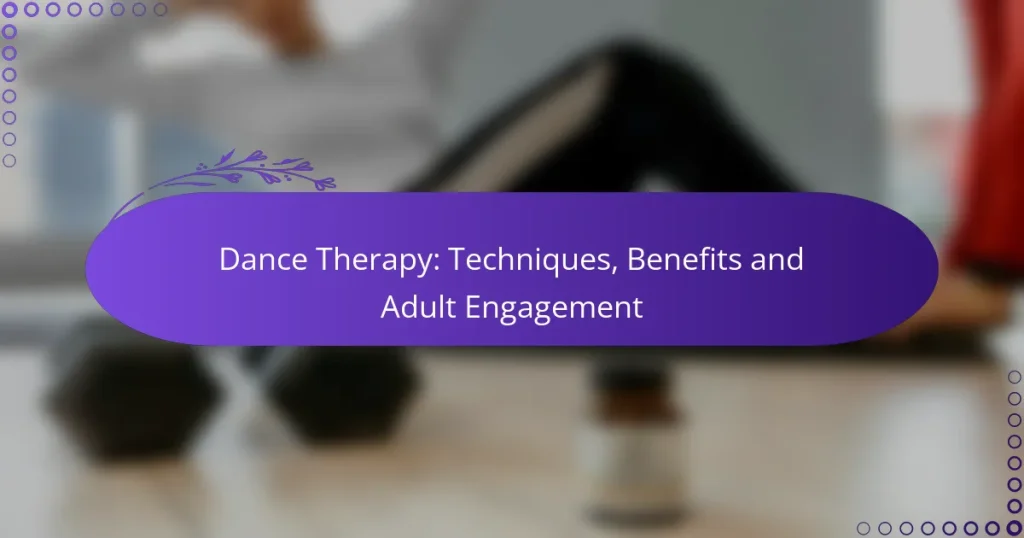Dance therapy is a powerful approach that harnesses movement to enhance mental health, physical well-being, and emotional expression in adults. By utilizing techniques such as improvisational dance and guided imagery, participants can explore their feelings and promote healing in a supportive environment. Engaging in dance therapy through classes or workshops allows individuals to connect with themselves and others, fostering a sense of community and wellness.
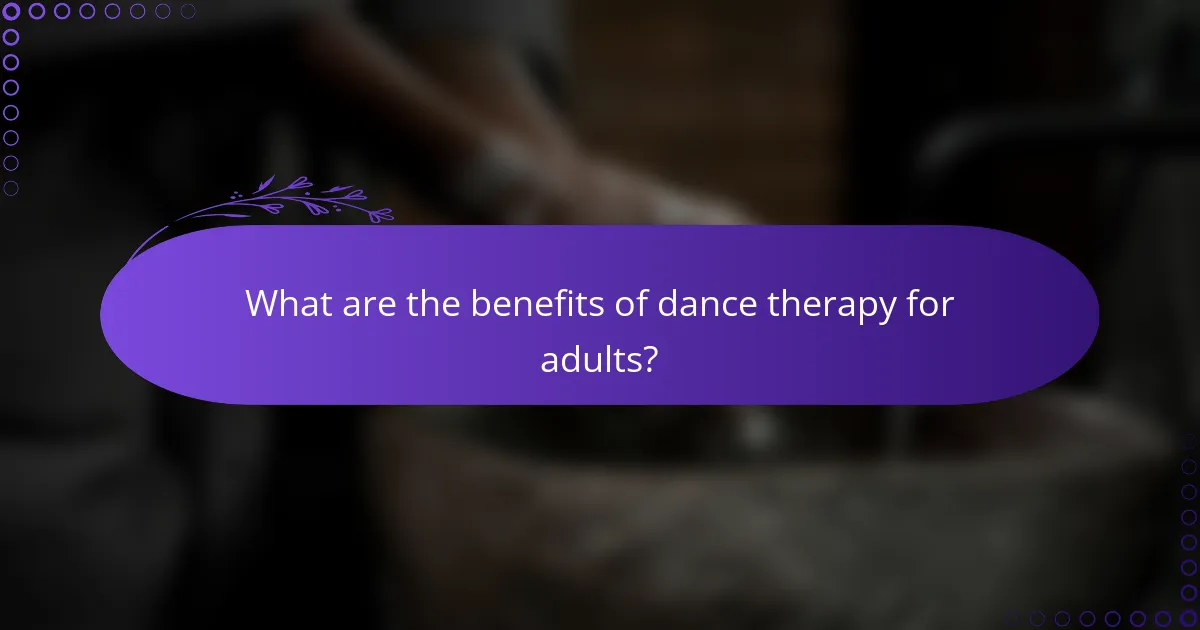
What are the benefits of dance therapy for adults?
Dance therapy offers numerous benefits for adults, including improved mental health, enhanced physical well-being, and increased emotional expression. Through movement and dance, individuals can experience therapeutic effects that promote overall wellness and social engagement.
Improves mental health
Dance therapy can significantly enhance mental health by reducing symptoms of anxiety and depression. Engaging in dance encourages the release of endorphins, which can elevate mood and foster a sense of well-being.
Additionally, dance therapy provides a creative outlet for self-expression, allowing individuals to process emotions and experiences in a supportive environment. Regular participation can lead to long-term improvements in mental resilience.
Enhances physical well-being
Participating in dance therapy promotes physical fitness by improving flexibility, strength, and coordination. The varied movements involved in dance can serve as a low-impact exercise option, making it accessible for many adults.
Moreover, consistent engagement in dance therapy can help manage weight, improve cardiovascular health, and enhance overall physical stamina. This holistic approach to fitness supports both body and mind.
Boosts emotional expression
Dance therapy encourages individuals to express their emotions through movement, which can be particularly beneficial for those who struggle with verbal communication. This non-verbal form of expression allows for deeper emotional exploration and release.
By using dance as a medium, participants can explore complex feelings and experiences, leading to greater emotional clarity and understanding. This process often results in a more profound connection to oneself and others.
Fosters social connections
Engaging in dance therapy often takes place in group settings, which can help foster social connections among participants. These shared experiences create a sense of community and belonging, reducing feelings of isolation.
Through collaborative dance activities, individuals can build trust and empathy, enhancing their social skills and relationships. This supportive environment is crucial for personal growth and emotional healing.
Increases self-awareness
Dance therapy promotes self-awareness by encouraging individuals to connect with their bodies and emotions. This heightened awareness can lead to better understanding of personal triggers and responses, facilitating personal growth.
As participants explore different movements and rhythms, they gain insights into their emotional states and behavioral patterns. This self-discovery process is vital for developing coping strategies and improving overall mental health.
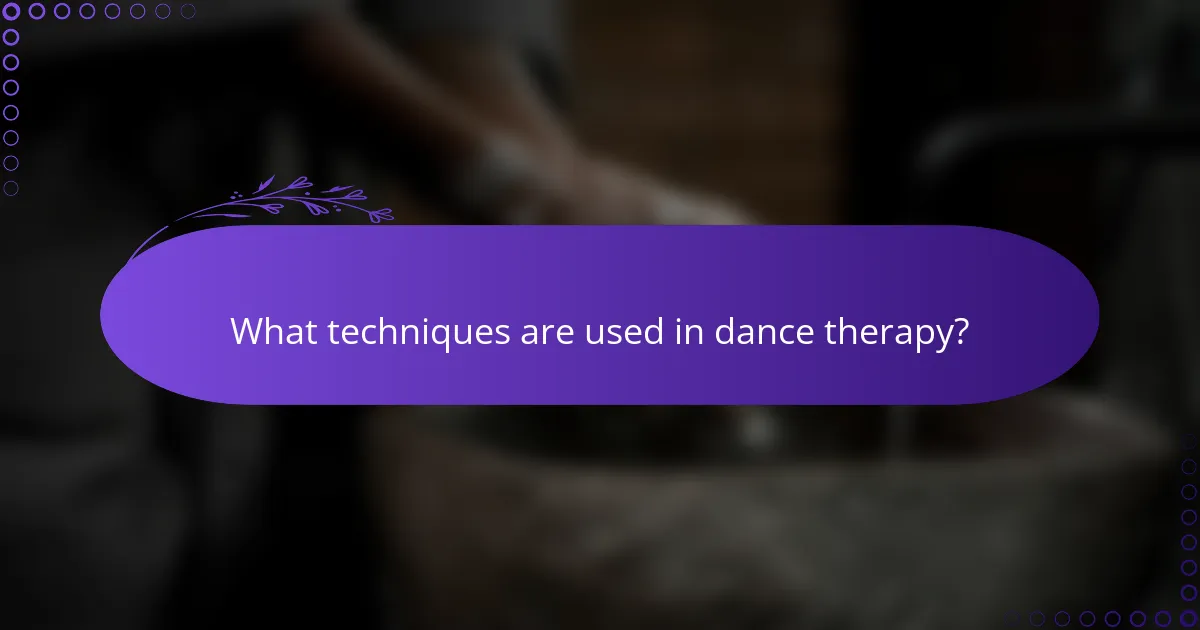
What techniques are used in dance therapy?
Dance therapy employs various techniques to facilitate emotional expression and healing through movement. These methods include improvisational dance, choreographed movement, guided imagery, and movement analysis, each serving distinct therapeutic purposes.
Improvisational dance
Improvisational dance encourages spontaneous movement, allowing individuals to express emotions freely without the constraints of structured choreography. This technique promotes self-discovery and can help participants connect with their feelings and experiences in a non-verbal way.
In practice, therapists may create a safe space where participants can explore movement based on their emotions or music. This can lead to greater self-awareness and emotional release, making it a powerful tool in therapy.
Choreographed movement
Choreographed movement involves pre-planned sequences that participants learn and perform. This technique can enhance coordination, body awareness, and social interaction, as individuals work together to create a unified performance.
Incorporating choreography can also provide a sense of accomplishment and boost self-esteem. Therapists often tailor the complexity of the movements to suit the participants’ abilities, ensuring an inclusive experience.
Guided imagery
Guided imagery combines movement with visualization techniques, helping participants create mental images that enhance their dance experience. This method can deepen emotional engagement and facilitate relaxation, making it easier to explore feelings and memories.
During sessions, therapists may lead participants through visualizations, such as imagining a peaceful landscape while moving, which can help reduce anxiety and promote a sense of calm. This technique is particularly useful for those who may struggle with verbal expression.
Movement analysis
Movement analysis involves observing and interpreting the way individuals move, providing insights into their emotional and psychological states. This technique helps therapists understand participants’ non-verbal communication and can guide the therapeutic process.
By analyzing movement patterns, therapists can identify areas of tension or discomfort, allowing for targeted interventions. This approach fosters a deeper connection between the mind and body, enhancing the overall therapeutic experience.
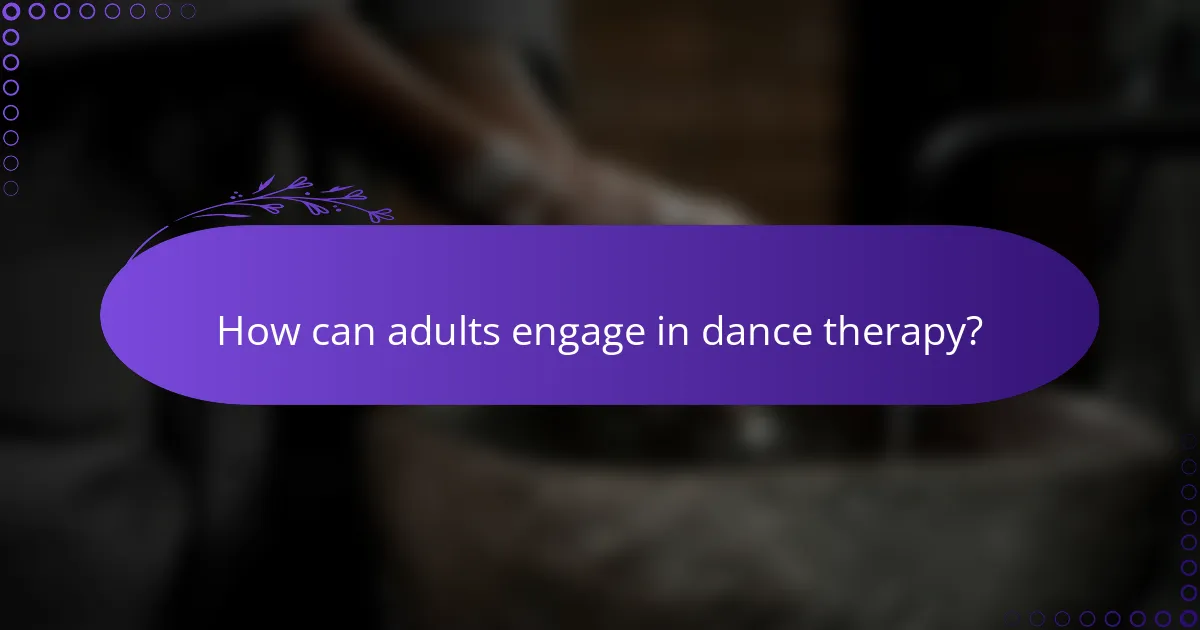
How can adults engage in dance therapy?
Adults can engage in dance therapy through various avenues, including local classes, workshops, and sessions with certified therapists. These options provide structured environments where individuals can explore movement as a form of expression and healing.
Joining local classes
Local dance therapy classes offer a community setting where adults can learn and practice therapeutic dance techniques. These classes often cater to different skill levels and may focus on specific styles, such as contemporary or expressive dance.
When selecting a class, consider factors like the instructor’s qualifications, class size, and the overall atmosphere. Many community centers and studios offer drop-in options, making it easy to try out a class without a long-term commitment.
Participating in workshops
Workshops provide intensive, short-term experiences that can deepen understanding of dance therapy. These sessions typically focus on specific themes or techniques, allowing participants to immerse themselves in the practice.
Look for workshops that are led by experienced facilitators and offer a safe space for exploration. They may range from a few hours to several days, often culminating in a performance or group sharing session.
Working with certified therapists
Engaging with certified dance therapists offers personalized guidance tailored to individual needs. These professionals are trained to use movement as a therapeutic tool, addressing emotional, psychological, and physical challenges.
When seeking a therapist, verify their credentials and experience in dance therapy. Sessions can be conducted one-on-one or in small groups, and they often incorporate various techniques to promote healing and self-discovery.

What prerequisites are needed for dance therapy?
Dance therapy does not require specific prerequisites, making it accessible to a wide range of individuals. Participants should be open to exploring movement and expressing themselves through dance, regardless of their previous experience.
No prior dance experience required
One of the key aspects of dance therapy is that it welcomes individuals without any dance background. This inclusivity allows participants to engage with their bodies and emotions freely, focusing on personal expression rather than technical skill. Many therapists emphasize that the goal is not to perform but to connect with oneself and others through movement.
For those concerned about their lack of experience, it can be helpful to remember that dance therapy is about exploration and self-discovery. Participants are encouraged to move at their own pace and comfort level, fostering a supportive environment where everyone can feel safe to express themselves.
Open-mindedness to movement
Being open-minded about movement is essential for maximizing the benefits of dance therapy. Participants should approach the sessions with a willingness to explore different forms of movement, which can enhance emotional release and personal insight. This openness can lead to a deeper understanding of one’s body and feelings.
To cultivate this mindset, individuals can practice letting go of self-judgment and preconceived notions about dance. Engaging in simple movements, such as swaying or stretching, can help ease participants into the experience. It’s important to remember that each person’s journey in dance therapy is unique, and embracing one’s own rhythm is key to the process.
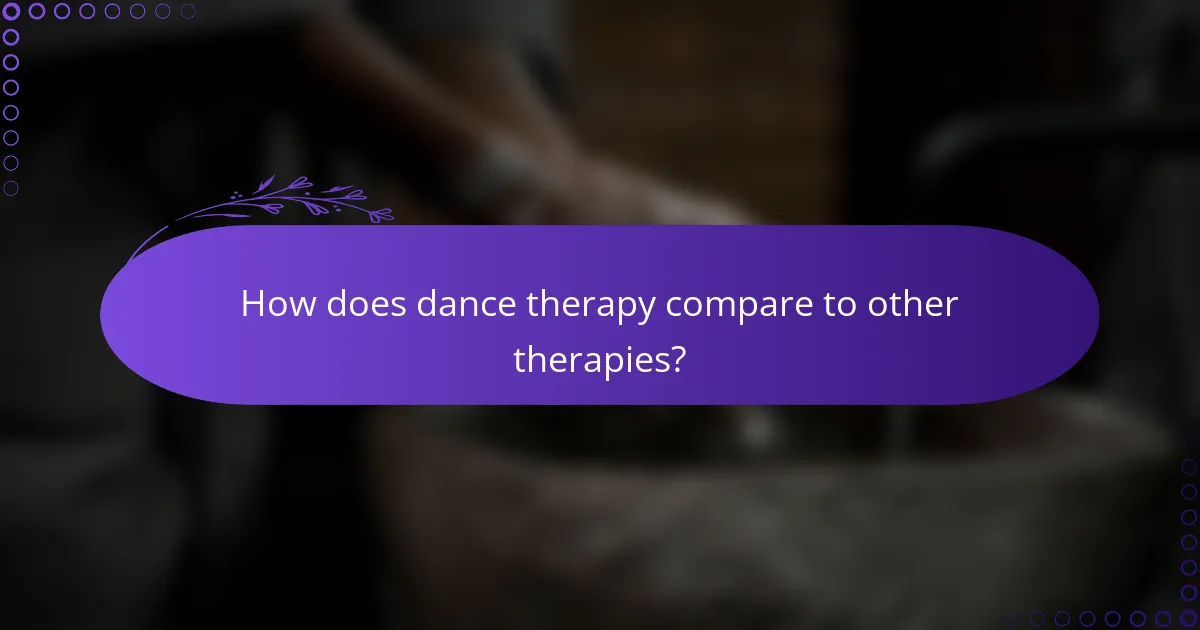
How does dance therapy compare to other therapies?
Dance therapy offers a unique approach to emotional and physical healing, distinct from traditional therapies like talk therapy or cognitive behavioral therapy. It integrates movement with emotional expression, allowing individuals to explore feelings and experiences through dance.
Unique aspects of dance therapy
Dance therapy focuses on the body as a means of communication and expression, which can be particularly beneficial for those who find verbal communication challenging. Unlike conventional therapies that primarily rely on dialogue, dance therapy encourages participants to express their emotions through movement, tapping into non-verbal cues and body language.
This therapy often incorporates improvisation and creative movement, allowing for a personalized experience that can adapt to the individual’s emotional state. This flexibility can lead to breakthroughs in self-awareness and emotional release.
Benefits compared to other therapies
One of the primary benefits of dance therapy is its ability to promote physical wellness alongside emotional healing. Engaging in dance can improve physical fitness, coordination, and body awareness, which are not typically emphasized in other therapeutic modalities.
Moreover, dance therapy can foster a sense of community and connection among participants, which is particularly valuable in group settings. This social aspect can enhance motivation and support, making it easier for individuals to engage in their healing process.
Considerations when choosing therapy
When deciding between dance therapy and other forms of therapy, consider personal preferences and comfort levels with movement. Some individuals may feel more at ease expressing themselves through dance, while others may prefer the structured dialogue of talk therapy.
It’s also essential to evaluate the qualifications of the therapist. Dance therapists should have specialized training in both dance and therapeutic techniques, ensuring they can provide effective support tailored to individual needs.
